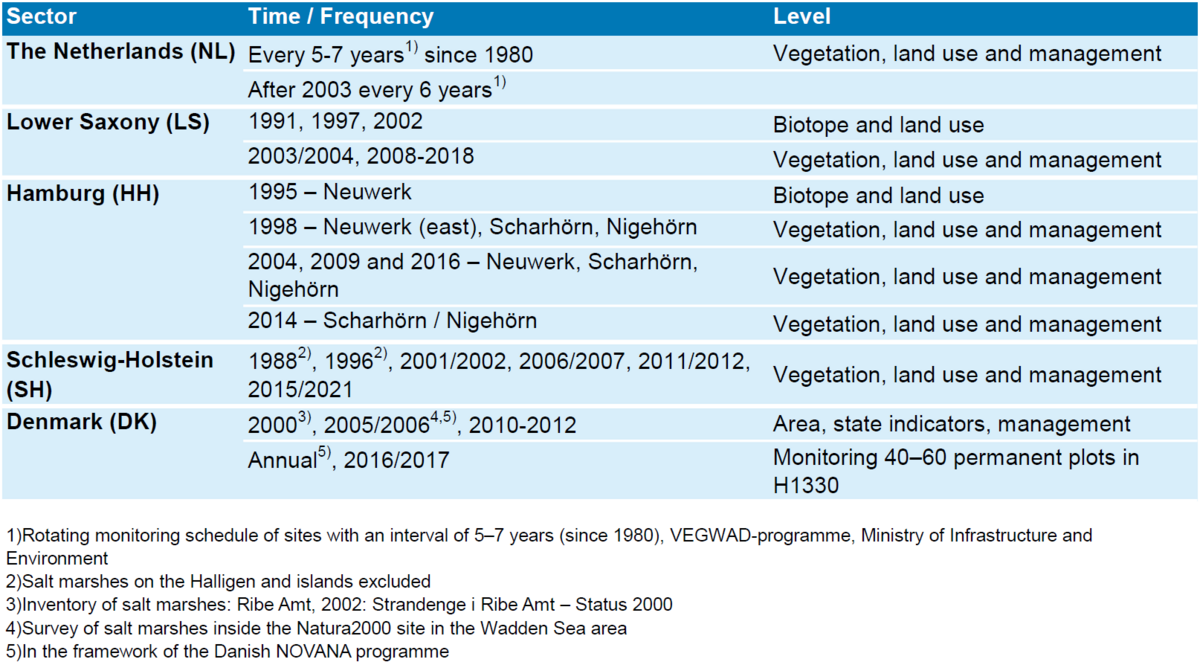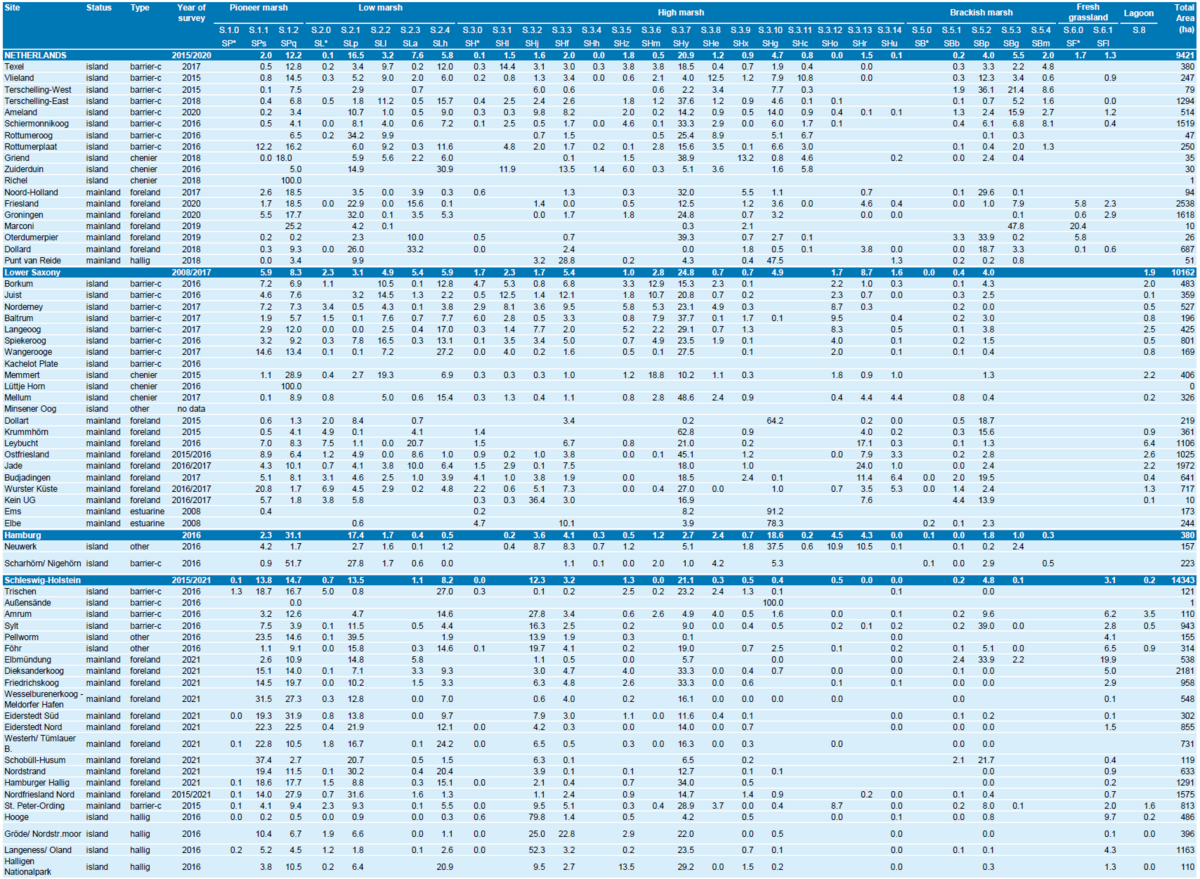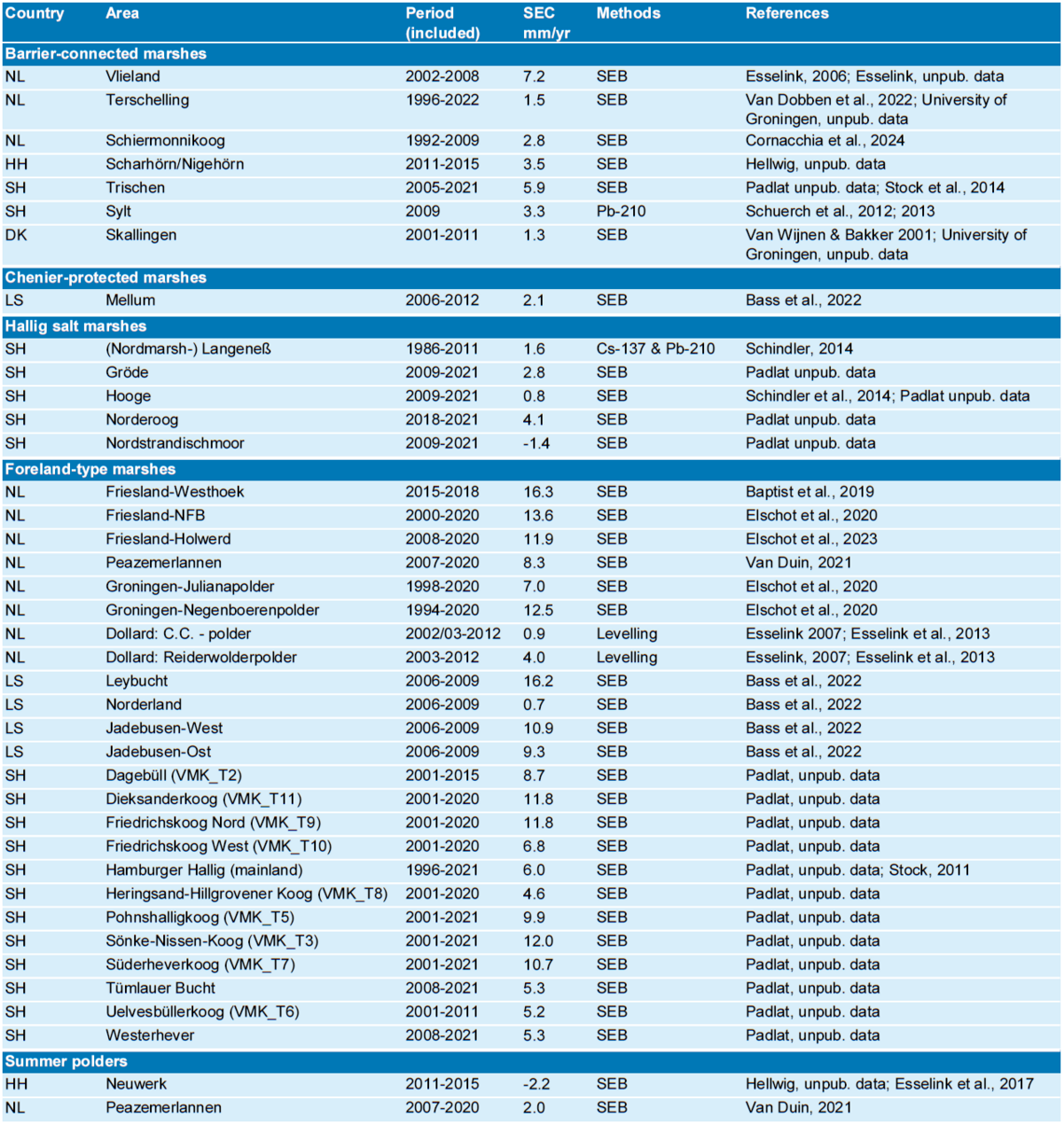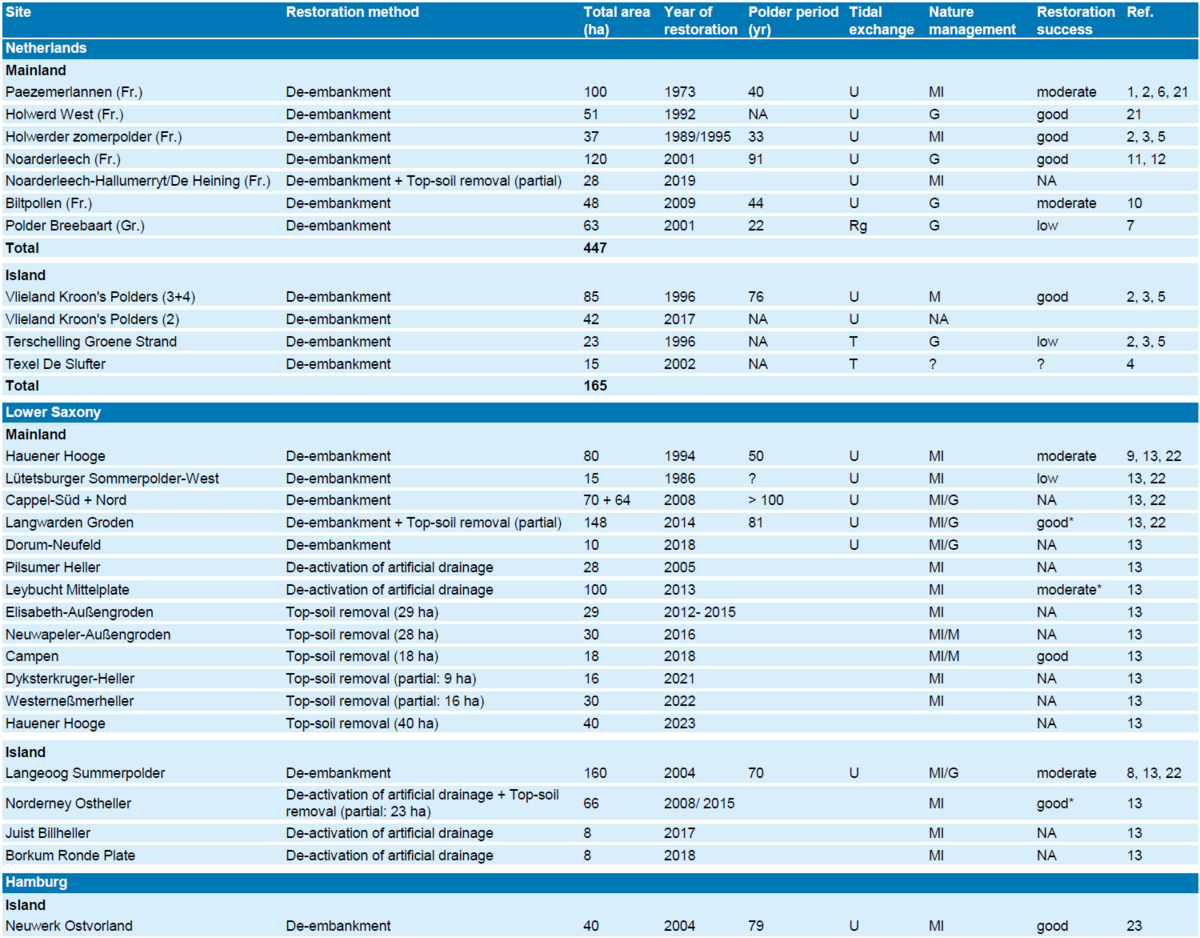Annex "Salt marshes"
Annex I: Methods
Table I: Overview of available vegetation monitoring data of salt marshes in the countries covering the whole area (GIS data, based on aerial photographs and ground truth covering the whole Wadden Sea area) (Download Table as PDF).
Annex II: Incidence of salt-marsh vegetation types and habitat types in the Wadden Sea
Table II.1. Incidence (% cover area) of vegetation types across the Netherlands and German sectors of the Wadden Sea specified per island and site on the mainland coast based on the most recent survey per sector (Download Table as PDF).
Table II.2. Incidence (% cover area) of salt-marsh habitat types in the Danish Wadden Sea based on the most recent survey (Download Table as PDF).
Annex III: Inventory of recent accretion studies in Wadden Sea salt marshes
Table III: Inventory of surface-elevation change (SEC) in Wadden Sea salt marshes, limited to data used in this report and collected after 2000 (if possible). The table presents the data that were used to compile Figure 7. Each site was considered as a single case and spatial resolution per site varied (Download Table as PDF).
Annex IV: Overview of coastal realignment sites and restoration projects in the Wadden Sea
Table IV: The degree of restoration success was based on expert judgement according to the extent and diversity of salt-marsh vegetation. In Lower Saxony three projects were systematically evaluated based on geomorphology, hydrology, vegetation and bird data (*). Tidal exchange is unrestricted (U), regulated (Rg) or unrestricted only above an elevated threshold (T). Nature management varies between minimum intervention (MI), livestock grazing (G) and mowing (M). NA = no information available or no long-term monitoring data available to evaluate restoration success (Download Table as PDF).
ReferencesBakker R., Bijkerk W., Esselink P. (2014) Monitoring effecten van verkweldering in de Bildtpollen 2009 – 2013. Eindrapport. A&W-rapport 1983, PUCCIMAR-rapport 11, Altenburg & Wymenga ecologisch onderzoek, Feanwâlden / PUCCIMAR Ecologisch onderzoek & Advies, Vries. 46 pp. Baptist M.J., Gerkema T., van Prooijen B.C., van Maren D.S., van Regteren M., Schulz K., Colosimo I., Vroom J., van Kessel T., Grasmeijer B.,. Willemsen P, Elschot K., de Groot A.V., Cleveringa J., van Eekelen E.M.M., Schuurman F., de Lange H.J., van Puijenbroek M.E.B. (2019) Beneficial use of dredged sediment to enhance salt marsh development by applying a ‘Mud motor’. Ecological Engineering 127: 312-323. Barkowski J.W., Kolditz K., Brumsack H., Freund H. (2009) The impact of tidal inundation on salt marsh vegetation after de-embankment on Langeoog Island, Germany – six-year time series of permanent plots. Journal of Coastal Conservation 13: 185–206. Bass J., Granse D., Hache I.,Jensen K., Karius V., Minden V., Stock M., Suchrow S., Kleyer M. (2022) Plant traits affect vertical accretion of salt marshes. Estuarine, Coastal and Shelf Science 276: 108010. Chang E.R., Veeneklaas R.M., Bakker J.P., Daniels P., Esselink P. (2016) What factors determined restoration success of a salt marsh ten years after de-embankment? Applied Vegetation Science 19: 66–77. Cornacchia L., Bakker, J.P., Koppenaal E.C., de Groot A.V. Olff H., van de Koppel, J., van der Wal, D., Bouma T.J. (2024) Spatial and temporal variation in long–term sediment accumulation in a back–barrier salt marsh. Geomorphology 456: 109191 de Leeuw C., Meijer M.-L. (2004) Proefgebieden herstel zoet-zout overgangen in Noord Nederland. Een beschrijving van 18 projecten. Rapport RIKZ/2003.010. RIKZ, Haren, Koeman en Bijkerk, Haren. 104 pp. Elschot K., Baptist M.J., van Puijenbroek M.E.B. (2023) Biocompacting livestock accelerate drowning of tidal salt marshes with sea level rise. Frontiers in Marine Science 10: 1–19. Elschot K., van Puijenbroek M.E.B., Lagendijk D.D.G., Van der Wal T.J., Sonneveld C. (2020) Lange-termijnontwikkeling van kwelders in de Waddenzee (1960-2018). Wettelijke Onderzoekstaken Natuur & Milieu, WOt-technical report 182, Wageningen Marine Research, Den Helder. Esselink P. (2006) Hoogteontwikkeling van de Kroon’s Polders (Vlieland). Monitoring over de periode 2002 – 2006 door middel van sedimentatie-erosie-balk metingen. Rapport 2006-137, Koeman en Bijkerk bv, Haren. 28 pp. Esselink P. (2007) Hoogteontwikkeling verwaarloosde landaanwinningskwelder. Opslibbing van de Dollardkwelders in de periode 1991–2003 met een vergelijking over de periode 1984 – 1991. Rapport 2007-009, Koeman en Bijkerk bv, Haren. 36 pp. Esselink P., de Leeuw C., Graveland J., Berg G.J. (2003) Ecologische Evaluatie Programma Herstel en Inrichting zoute wateren 1990-1999. Report RIKZ/2003.028. Rijkswaterstaat Rijksinstituut voor Kust en Zee / RIKZ, Middelburg. 49 pp. + app. Esselink P., Berg G.J. (2007) Beheerplan Polder Breebaart. Report 2005-100, Bureau Koeman en Bijkerk, Haren. 77 pp. Esselink P., Petersen J., Arens S., Bakker J.P., Bunje J., Dijkema K.S., Hecker N., Hellwig U., Jensen A.-V., Kers A.S., Körber P., Lammerts E.J., Stock M., Veeneklaas R.M., Vreeken M., Wolters M. (2009) Salt Marshes. Thematic Report No. 8. In: H. Marencic & J. de Vlas (eds). Quality Status Report 2009. Wadden Sea Ecosystem No. 25. Common Wadden Sea Secretariat, Trilateral Monitoring and Assessment Group, Wilhelmshaven, Germany. 54 pp. Esselink P., Daniels P., Weerstand P. (2013) De hoogte van de Dollardkwelders in 2012: Beschrijving van de uitgangssituatie in het kader van het Kwelderherstelprogramma Groningen. PUCCIMAR rapport 10. PUCCIMAR Ecologisch Onderzoek & Advies, Vries. 31 pp. Esselink P., Bos D., Daniels P., van Duin W.E., Veeneklaas R.M. (2015) Van polder naar kwelder: tien jaar kwelderherstel Noarderleech. PUCCIMAR-rapport 06, PUCCIMAR Ecologisch Onderzoek & Advies, Vries. 209 pp. Esselink P., van Duin W.E., Bunje J., Cremer J., Folmer E.O., Frikke J., Glahn M., de Groot A.V., Hecker N., Hellwig U., Jensen K., Körber P., Petersen J. & Stock M. (2017) Salt marshes. In: Wadden Sea Quality Status Report. Eds.: Kloepper S. et al., Common Wadden Sea Secretariat, Wilhelmshaven, Germany. Last updated 21.12.2017. Downloaded 25.10.2023. qsr.waddensea-worldheritage.org/reports/salt-marshes-2017 Kolditz K., Dellwig, O., Barkowski, J., Bedewien T.H., Fruend H., Brumsack H.J. (2012) Geochemistry of salt marsh sediments deposited during simulated sea-level rise and consequences for recent and Holocene coastal development of NW Germany. Geo-Mar Lett 32, 49–60. Rupprecht F., Reichert G., Merling B., Oltmanns B. (2023) Renaturierung von Salzwiesen im Nationalpark Niedersächsisches Wattenmeer. Berichte aus dem Nationalpark und der Biospärenregion, Niedersächsisches Wattenmeer 2023-03. Schuerch M., Rapaglia J., Liebetrau V., Vafeidis A., Reise K. (2012) Salt marsh accretion and storm tide variation: An example from a barrierisland in the North Sea. Estuar. Coast 35: 486–500 Schuerch M., Vafeidis A., Slawig T., Temmerman S. (2013) Modeling the influence of changing storm patterns on the ability of a salt marsh to keep pace with sea level rise. J. Geophys. Res. Earth Surf., 118: 84–96. Schindler M., Karius V., Arns A., Deicke M., von Eynatten H. (2014) Measuring sediment deposition and accretion on anthropogenic marshland Part II: The adaptation capacity of the North Frisian Halligen to sea level rise. Estuarine, Coastal and Shelf Science 151: 246-255. Stock M. (2011) Patterns in surface elevation change across a temperate salt marsh platform in relation to sea-level rise. In: V. Karius, H. Hadler, M. Deicke, H. von Eynatten, H. Brückner & A. Vött (eds): Dynamische Küsten – Prozesse, Zusammenhänge und Auswirkungen, Coastline Reports 17, Göttingen, Mainz & Köln, pp. 33–48. van Dobben H., de Groot A.V., Bakker J.P. (2022) Salt marsh accretion with and without deep soil subsidence as a proxy for sea-level rise. Estuaries and Coasts 45: 1562-1582. van Duin W.E., Dijkema K.S., Zegers J. (1997) Veranderingen in bodemhoogte (opslibbing, erosie en inklink) in de Peazemerlannen. IBN-rapport 326. Instituut voor Bos- en Natuuronderzoek (IBN-DLO), Wageningen. 104 pp. van Duin W.E., K.S. Dijkema & P.-W. van Leeuwen. (2007) Uitgangssituatie maaiveldhoogte en kweldervegetatie in de Paezemerlannen (2006). Report C128/07. IMARES, Wageningen. 79 pp. van Duin W.E. (2021) Kweldermonitoring in de Peazemerlannen en referentiegebieden: Jaarrapport 2020. Artemisia-rapport 2021-01, Artemisia-kwelderonderzoek, Den Helder. 84p. van Wijnen H.J., Bakker J.P. (2001) Long-term surface elevation change in salt marshes: a prediction of marsh response to future sea-level rise. Estuarine, Coastal and Shelf Science 52: 381–39 Wolters M., Garbutt A., Bakker J.P. (2005) Salt-marsh restoration: evaluating the success of de-embankments in north-west Europe. Biological Conservation 123: 249–268. |





